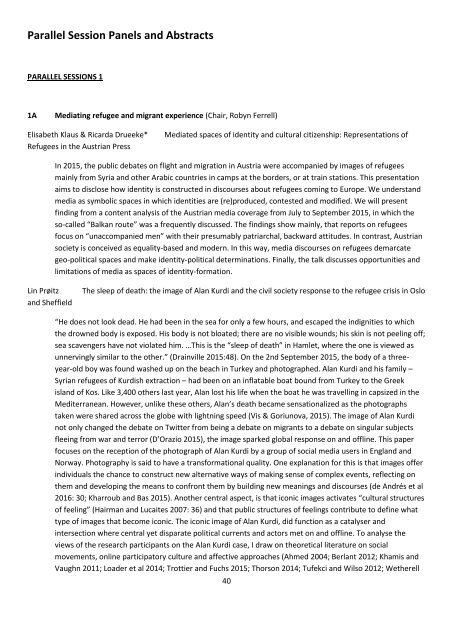Crossroads in Cultural Studies Conference 14-17th December 2016 Program Index
Crossroads-2016-final-draft-program-30-Nov
Crossroads-2016-final-draft-program-30-Nov
You also want an ePaper? Increase the reach of your titles
YUMPU automatically turns print PDFs into web optimized ePapers that Google loves.
Parallel Session Panels and Abstracts<br />
PARALLEL SESSIONS 1<br />
1A<br />
Mediat<strong>in</strong>g refugee and migrant experience (Chair, Robyn Ferrell)<br />
Elisabeth Klaus & Ricarda Drueeke*<br />
Refugees <strong>in</strong> the Austrian Press<br />
Mediated spaces of identity and cultural citizenship: Representations of<br />
In 2015, the public debates on flight and migration <strong>in</strong> Austria were accompanied by images of refugees<br />
ma<strong>in</strong>ly from Syria and other Arabic countries <strong>in</strong> camps at the borders, or at tra<strong>in</strong> stations. This presentation<br />
aims to disclose how identity is constructed <strong>in</strong> discourses about refugees com<strong>in</strong>g to Europe. We understand<br />
media as symbolic spaces <strong>in</strong> which identities are (re)produced, contested and modified. We will present<br />
f<strong>in</strong>d<strong>in</strong>g from a content analysis of the Austrian media coverage from July to September 2015, <strong>in</strong> which the<br />
so-called “Balkan route” was a frequently discussed. The f<strong>in</strong>d<strong>in</strong>gs show ma<strong>in</strong>ly, that reports on refugees<br />
focus on “unaccompanied men” with their presumably patriarchal, backward attitudes. In contrast, Austrian<br />
society is conceived as equality-based and modern. In this way, media discourses on refugees demarcate<br />
geo-political spaces and make identity-political determ<strong>in</strong>ations. F<strong>in</strong>ally, the talk discusses opportunities and<br />
limitations of media as spaces of identity-formation.<br />
L<strong>in</strong> Prøitz<br />
and Sheffield<br />
The sleep of death: the image of Alan Kurdi and the civil society response to the refugee crisis <strong>in</strong> Oslo<br />
“He does not look dead. He had been <strong>in</strong> the sea for only a few hours, and escaped the <strong>in</strong>dignities to which<br />
the drowned body is exposed. His body is not bloated; there are no visible wounds; his sk<strong>in</strong> is not peel<strong>in</strong>g off;<br />
sea scavengers have not violated him. …This is the “sleep of death” <strong>in</strong> Hamlet, where the one is viewed as<br />
unnerv<strong>in</strong>gly similar to the other.” (Dra<strong>in</strong>ville 2015:48). On the 2nd September 2015, the body of a threeyear-old<br />
boy was found washed up on the beach <strong>in</strong> Turkey and photographed. Alan Kurdi and his family –<br />
Syrian refugees of Kurdish extraction – had been on an <strong>in</strong>flatable boat bound from Turkey to the Greek<br />
island of Kos. Like 3,400 others last year, Alan lost his life when the boat he was travell<strong>in</strong>g <strong>in</strong> capsized <strong>in</strong> the<br />
Mediterranean. However, unlike these others, Alan’s death became sensationalized as the photographs<br />
taken were shared across the globe with lightn<strong>in</strong>g speed (Vis & Goriunova, 2015). The image of Alan Kurdi<br />
not only changed the debate on Twitter from be<strong>in</strong>g a debate on migrants to a debate on s<strong>in</strong>gular subjects<br />
flee<strong>in</strong>g from war and terror (D’Orazio 2015), the image sparked global response on and offl<strong>in</strong>e. This paper<br />
focuses on the reception of the photograph of Alan Kurdi by a group of social media users <strong>in</strong> England and<br />
Norway. Photography is said to have a transformational quality. One explanation for this is that images offer<br />
<strong>in</strong>dividuals the chance to construct new alternative ways of mak<strong>in</strong>g sense of complex events, reflect<strong>in</strong>g on<br />
them and develop<strong>in</strong>g the means to confront them by build<strong>in</strong>g new mean<strong>in</strong>gs and discourses (de Andrés et al<br />
<strong>2016</strong>: 30; Kharroub and Bas 2015). Another central aspect, is that iconic images activates “cultural structures<br />
of feel<strong>in</strong>g” (Hairman and Lucaites 2007: 36) and that public structures of feel<strong>in</strong>gs contribute to def<strong>in</strong>e what<br />
type of images that become iconic. The iconic image of Alan Kurdi, did function as a catalyser and<br />
<strong>in</strong>tersection where central yet disparate political currents and actors met on and offl<strong>in</strong>e. To analyse the<br />
views of the research participants on the Alan Kurdi case, I draw on theoretical literature on social<br />
movements, onl<strong>in</strong>e participatory culture and affective approaches (Ahmed 2004; Berlant 2012; Khamis and<br />
Vaughn 2011; Loader et al 20<strong>14</strong>; Trottier and Fuchs 2015; Thorson 20<strong>14</strong>; Tufekci and Wilso 2012; Wetherell<br />
40


